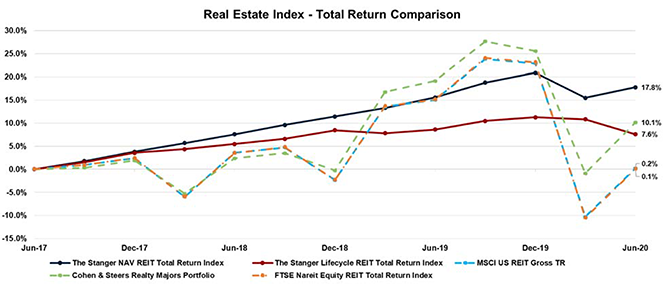NAV REITs Continue to Outperform Traded Counterparts

After the COVID-19 pandemic took its toll on real estate securities in the first quarter of 2020, with volatility walloping returns in the traded market, second quarter 2020 returns showed some signs of recovery.
After the COVID-19 pandemic took its toll on real estate securities in the first quarter of 2020, returns continued to show early signs of recovery during the second quarter of 2020, according to investment bank Robert A. Stanger & Company.
Following a 27 percent loss in the first quarter, the MSCI US REIT Index Gross Total Return (RMS G), a measure of performance of publicly traded REITs, posted an 11.7 percent gain during the second quarter of 2020.
Year-to-date, the RMS G posted a -18.5 percent total return, and the 36-month total return of this broader REIT market index was 0.2 percent.
Non-traded net asset value real estate investment trusts showed less dramatic declines in the first quarter, posting a 4.5 percent loss as measured by the Stanger NAV REIT Total Return Index, followed by a 2.0 percent gain during the second quarter. Year-to-date, the Stanger NAV REIT Index lost 2.6 percent.
During the 36-month period ending in June, non-traded NAV REITs had a cumulative total return of 17.4 percent.
“While we are seeing the beginnings of a recovery in the public markets, further near-term impact of the COVID-19 pandemic on both public and private market real estate values may still be seen,” Stanger noted.

“This performance only serves to highlight the benefits of a non-listed REIT vehicle, providing a real estate-based return without the extreme ongoing volatility of the traded market,” said Kevin T. Gannon, chairman and chief executive officer of Stanger.
The Stanger NAV REIT and Stanger Lifecycle REIT Total Return Indices measure the performance of non-traded REITs on a quarterly basis. Stanger began calculating the indices on December 31, 2015, with a base level of 100. All NAV REITs with a minimum of one calendar quarter of performance are included in the NAV REIT Index.
Lifecycle REITs are added to the Lifecycle REIT Index in the quarter that their first NAV is announced, and are removed from the index upon listing, merger, or in the case of a liquidation by sale of properties, upon conversion to a liquidation basis of accounting. The indices currently include 13 NAV REITs with a total of 67 separate share classes, and 46 lifecycle REITs with a total of 76 separate share classes.
Founded in 1978, Robert A. Stanger & Co. Inc. is a national investment banking firm specializing in providing investment banking, financial advisory, fairness opinion and asset and securities valuation services to partnerships, REITs, and real estate advisory and management companies in support of strategic planning and execution, capital formation and financings, mergers, acquisitions, reorganizations and consolidations.
Click here to visit The DI Wire directory sponsor page.